
Una bella raccolta di foto che mostra com’erano le donne cattive negli anni ’50. Probabilmente erano divertenti ma ribelli.
h/t: vintag.es































Una bella raccolta di foto che mostra com’erano le donne cattive negli anni ’50. Probabilmente erano divertenti ma ribelli.
h/t: vintag.es































Italian pin-up artist Gabriele Pennacchioli (previously featured) works for a number of world-renowned animation studios. The women in Gabriele’s works differ radically from the traditional and classic pin-up images of women in that they are modern, feminine and confident.
More: Instagram, Artstation











































































































Liverpool è una città e un distretto metropolitano nel Merseyside, in Inghilterra. È il decimo distretto inglese per popolazione e la sua area metropolitana è la quinta più grande del Regno Unito.
Di più: David Sinclair h/t: vintag.es

Nel 19° secolo, Liverpool era un importante porto di partenza per gli emigranti inglesi e irlandesi verso il Nord America. Fu anche sede della Cunard e della White Star Lines, ed era il porto di registrazione dei transatlantici RMS Titanic, RMS Lusitania, RMS Queen Mary e RMS Olympic.

Nel 2019, Liverpool è stata la quinta città più visitata del Regno Unito. È nota per la sua cultura, architettura e collegamenti di trasporto. La città è strettamente legata alle arti, in particolare alla musica; la popolarità dei Beatles, ampiamente considerata come la band più influente di tutti i tempi, l’ha portata a diventare una destinazione turistica.

I nativi di Liverpool, e alcuni residenti di lunga data, sono formalmente chiamati Liverpudlians ma sono spesso chiamati Scouser in riferimento allo Scouse, uno stufato locale reso popolare dai marinai della città, che è anche il nome più comune per l’accento e il dialetto locale.

Queste straordinarie foto in bianco e nero sono state scattate da David Sinclair e mostrano l’aspetto del Liverpool negli anni ’80.

















































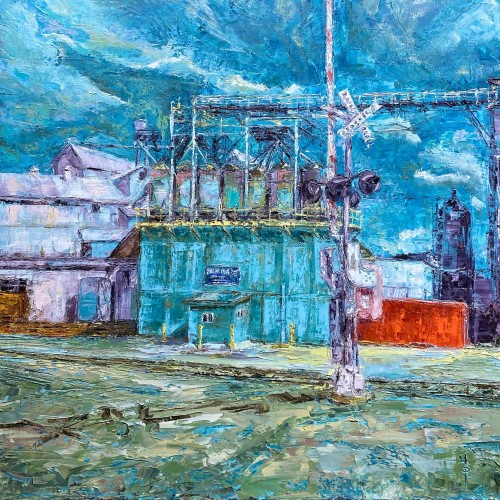
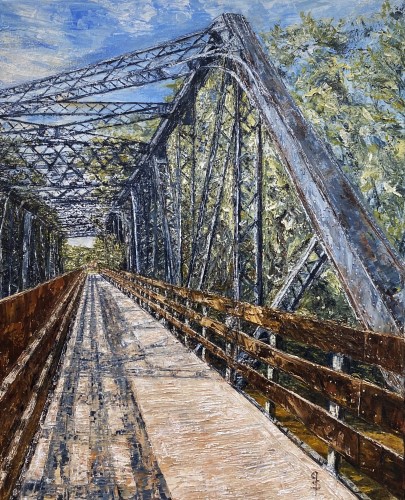
“Ponte a Nelsonville Yard” olio su tela, 30″ x 24″
È stato emozionante per me quando ho capito in seconda elementare, a soli 8 anni, che avevo la capacità di disegnare! Il mio insegnante ha riconosciuto che avevo un certo talento mentre aiutavo a disegnare un murale di Natale nella nostra classe. Ricordo che mi perdevo a disegnare mentre sedevo in classi che non mi interessavano. Ho fatto lo stesso mentre ero a casa quando non volevo fare i compiti.
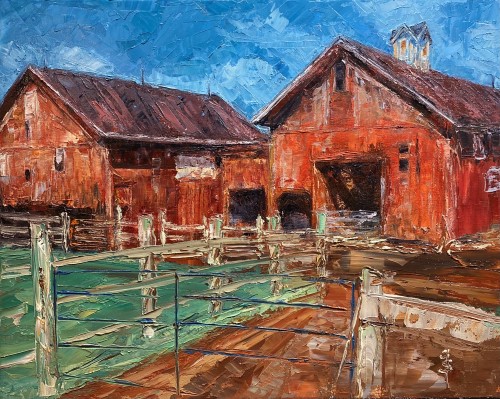
“Fienili di rosso” olio su tela, 11″ x 14″
Durante il liceo, ho seguito qualsiasi corso di arte disponibile. Purtroppo non sempre li ho trovati soddisfacenti. Ricordo che la mia arte era una fonte di frustrazione perché non ero abbastanza maturo per capirlo o abbastanza serio nel lavorare sodo per migliorare il mio talento.
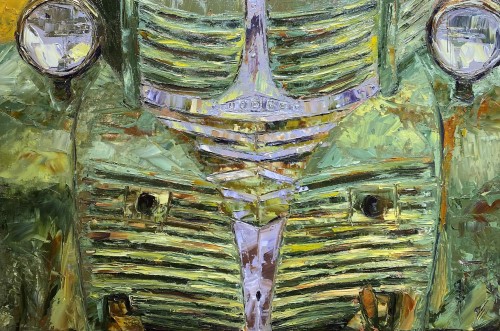
“Grill Out III” olio su tela, 24″ x 36″
Cinque mesi dopo essermi diplomato al liceo, mi sono sposato. Nel giro di due anni abbiamo fondato la nostra famiglia. Mentre crescevo le nostre quattro figlie, mi sono dilettato in creazioni di tipo furbo. Volevo migliorare e sviluppare ulteriormente la capacità creativa che ho avuto la fortuna di avere. ma poiché il mio tempo era limitato, continuavo a mettere continuamente la mia arte in secondo piano. Quando i nostri figli sono cresciuti e ho potuto ritirarmi dal lavoro come assistente medico, ho deciso che era il mio momento di fare sul serio ed esplorare il desiderio di dipingere che era sempre stato dentro di me.
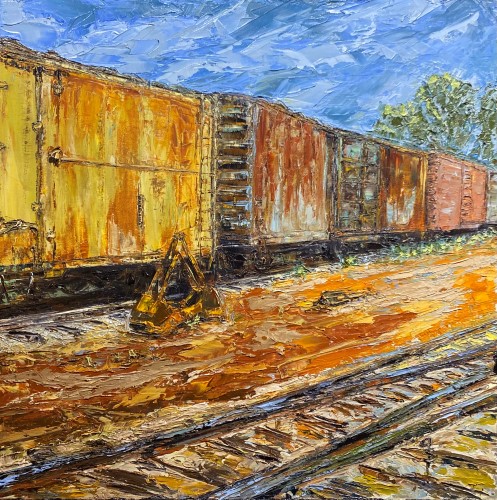
“Last Stop” olio su tela, 24″ x 24″
In passato, la mia arte era praticamente limitata a disegni a carboncino, pastelli e grafite. Ho sempre ammirato e sono stato attratto dalla pittura di composizioni con pennellate sciolte, mosso dal modo in cui i colori giusti insieme contrastavano tra loro per creare movimento.
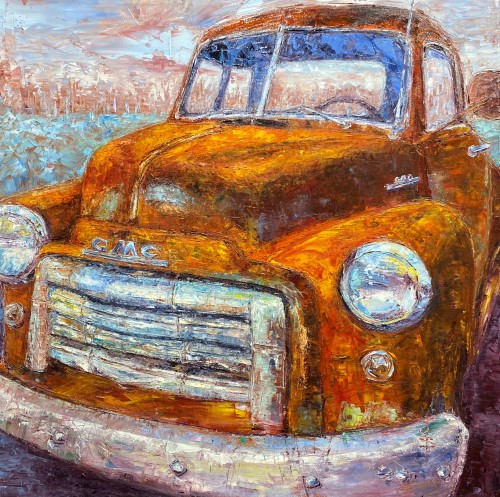
“Cromo e ruggine” olio su tela, 24″ x 24″
Ho deciso di iniziare con alcune lezioni online. Questo ha stuzzicato la mia voglia di saperne di più, quindi sono passato all’insegnamento in classe. Ancora oggi, continuo a partecipare a workshop e uscite plein air. Imparo molto dagli artisti di talento con cui mi associo.
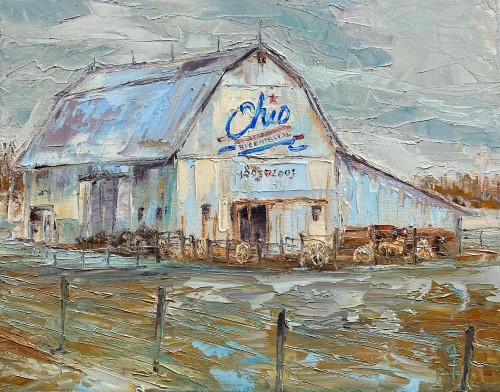
“Il bicentenario dell’Ohio” olio su tela, 11″ x 14″
Dopo un paio d’anni di pittura con i pennelli, ho scoperto la spatola. Adoro la versatilità di questo strumento! Sono diventato estremamente interessato alla pittura di vecchi veicoli, fienili alterati, attrezzature dimenticate e composizioni architettoniche uniche. Quello che ho scoperto è che la spatola consente la libertà di creare i tratti, la trama e i segni che desideravo per i miei dipinti. E dà loro una sensazione realistica e una scioltezza che avevo cercato di realizzare nel mio stile.
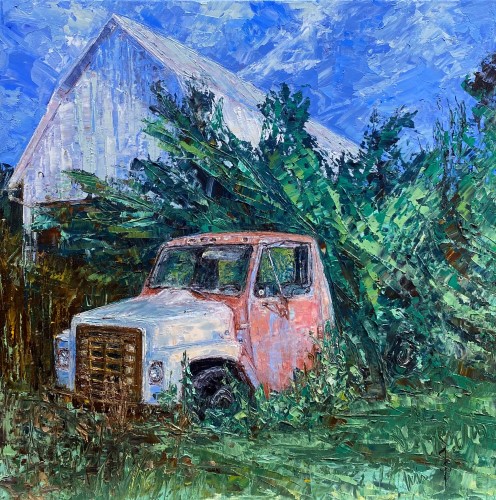
Olio su tela “sepolto”, 20″ x 20″
Anche se uso ancora un pennello per eseguire la pittura di fondo dei miei dipinti, la spatola è stata il mio unico strumento negli ultimi sette anni. La pittura è diventata la mia passione! Distrae la mia mente da tutto il resto e ha la capacità di trasportarmi ovunque io voglia essere. Questo è stato estremamente terapeutico durante la pandemia.
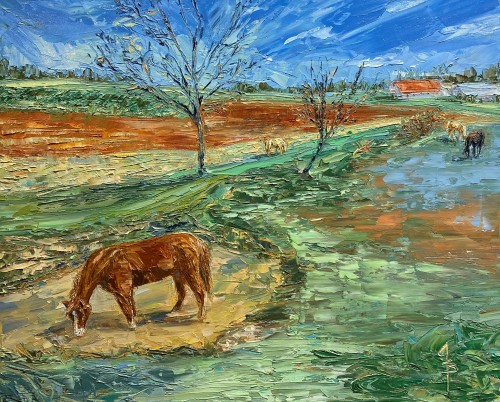
“Occupato” olio su tela, 16″ x 20″
Trovo grande soddisfazione mentre porto a termine una composizione, tanto che non vedo l’ora di iniziarne una nuova.
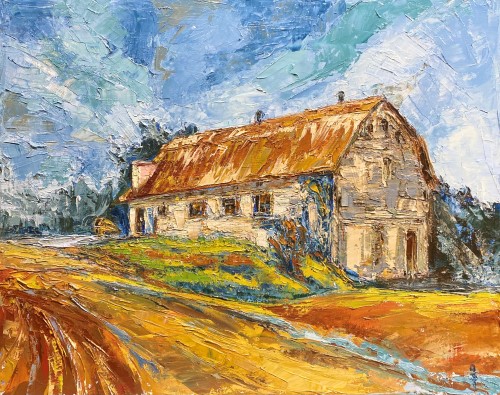
“Bellville” olio su lino, 16″ x 20″
La mia attuale ispirazione è stata quella di creare su tela tutto ciò che vedo che mi dà quella sensazione immediata di “esso”. Quel “esso” è quasi sempre vecchio: più arrugginito o consumato, meglio è. Potrebbe essere un veicolo abbandonato, o un fienile che ha visto giorni migliori in mezzo a un campo erboso. O la vecchia imponente architettura di un mangimificio con imposte.

Olio su tela “Traversata ferroviaria”, 24″ x 24″
Mi rendo conto che inizialmente non tutti vedono la bellezza nelle cose che faccio. È qui che entra in gioco la sfida per me. Il mio obiettivo è creare una composizione che permetta allo spettatore di vedere quel camion arrugginito, quel fienile malconcio o quel mangimificio del passato, in un modo completamente nuovo.
L’artista Gale Suver ti invita a seguirla Instagram e Facebook.

Vincent Van Gogh, The sowerArles, 17 – 28 June 1888 ca, Oil on canvas, 80.3 x 64.2 cm © Kröller-Müller Museum, Otterlo, The Netherland
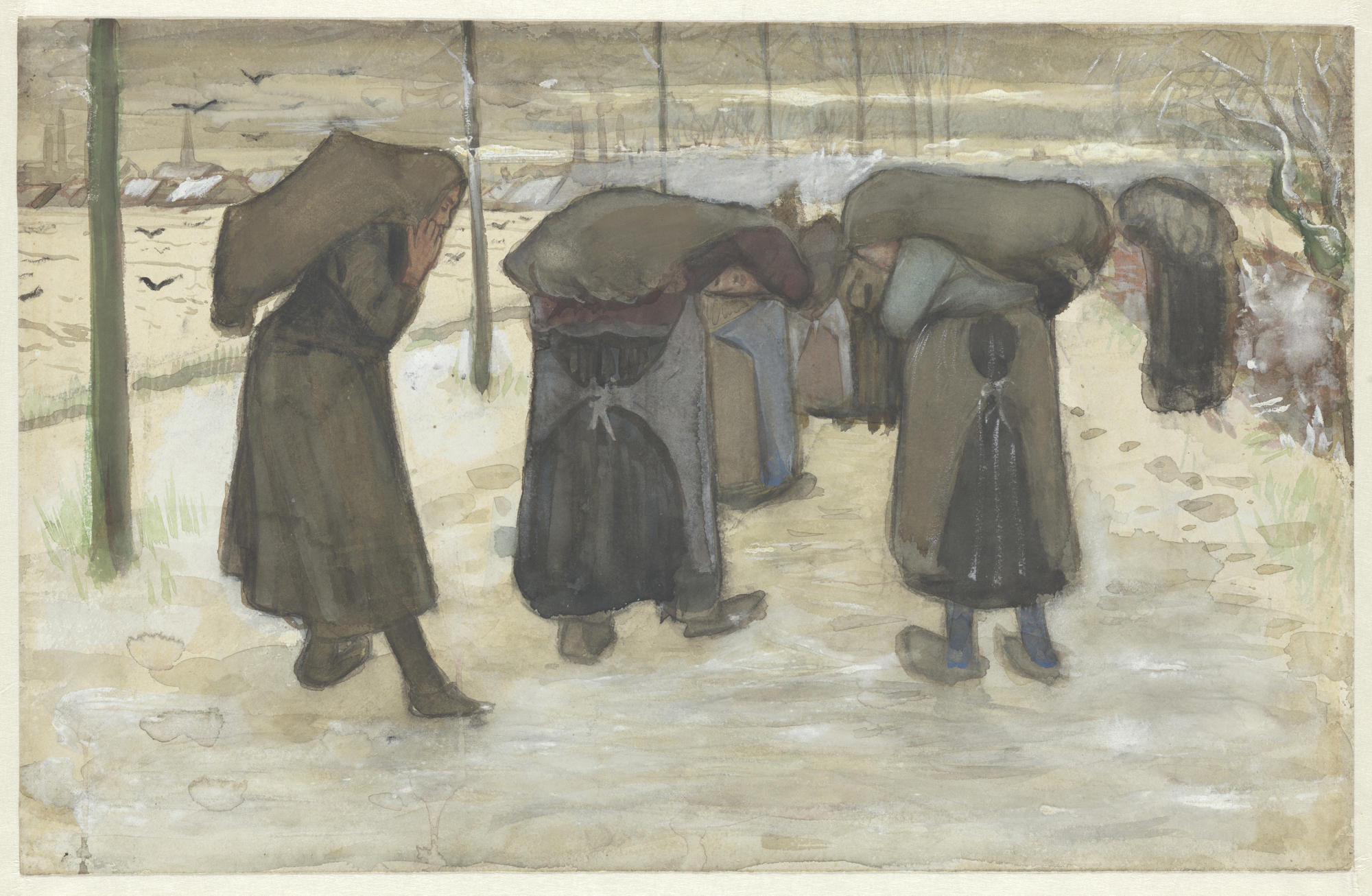
Vincent Van Gogh, Women in the Snow Carrying Sacks of Coal, The Hague, November 1882, Charcoal, opaque watercolor and ink on wove paper, 50.1 x 32.1 cm © Kröller-Müller Museum, Otterlo, The Netherlands
Vincent’s human and artistic life, told by his own words contained in the letters to his brother Theo, which characterize the extensive didactic apparatus of the exhibition, runs through the 50 works from the prestigious Kröller-Müller Museum in Otterlo, the great “house museum ”Born from the passion for art of Helene Kröller-Müller and which houses the largest number of works by the painter after the Van Gogh Museum in Amsterdam.
A chronological path, marked by the periods and places where the painter lived, from Holland to Paris, from Arles to St. Remy and Auvers-Sur-Oise, where he put an end to his tormented existence, leads the visitor, in an intense crescendo , from jobs like intimate friends Woman sewing and cat to the last dramatic Desperate old manof May 1890.
The realism learned by Jean François Millet and Charles François Dubign makes its way through the dark landscapes of youth from where sowers, potato pickers, weavers, woodcutters emerge, the woman intent on washing a pot and the one bent to collect wheat, and again Sien, the prostitute with the lost and poignant gaze or the wives of the Borinage miners crushed by the weight of the coal sacks, observed by Van Gogh as they advance through the snow.
And the guests of Palazzo Bonaparte, like Van Gogh, feel part of a world that lives in earthen huts.
We follow Vincent moving from Etten to The Hague, to Drenthe, to Nuenen, always looking for living testimonies of a world that has absolute value for him embodied in his figures.
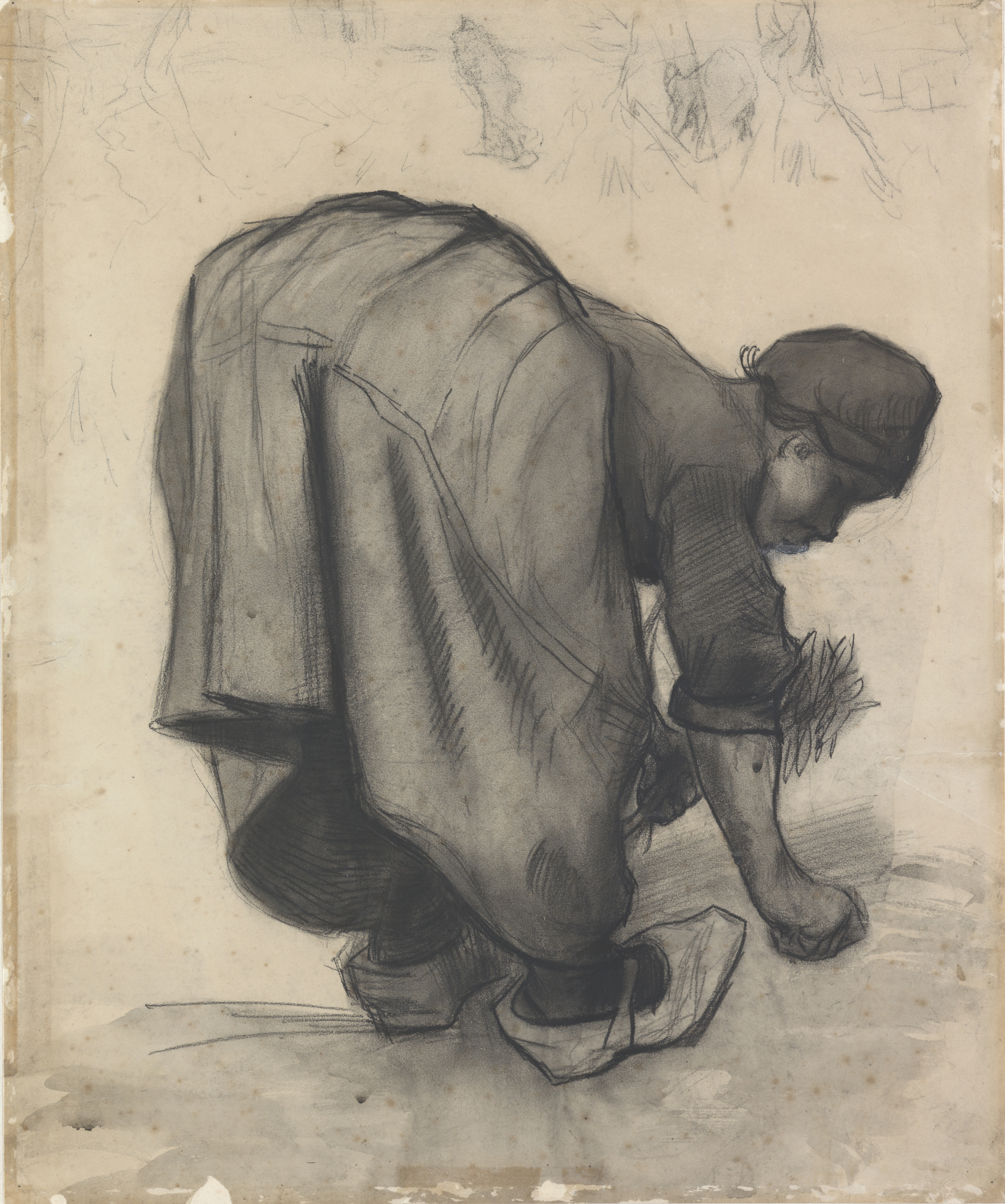
Vincent van Gogh, Farmer Gathering Wheat, Nuenen, July – August 1885, Black chalk, gray gouache, white opaque watercolor and traces of fixative milk on tissue paper, 43.2 x 52.2 cm © Kröller-Müller Museum, Otterlo, The Netherlands
Still life with straw hatwhere Van Gogh takes Anton Mauve’s lesson in opening up to color his own, is only a timid signal that anticipates the chromatic explosion that will take place on the canvas during the Parisian period, experienced starting from February 1888. This careful search for color in the wake impressionist, with the conquest of a more immediate and chromatically vibrant language, emerges in the path through the vibrant and “photographic” cut of Interior of a restaurant, a tribute to the Impressionists who loved to represent the joyful life of modernity. It is from 1887 Lawn corner for which the artist reuses an old canvas that revealed, from an X-ray examination, traces of a woman’s head with a white cap and birds’ nests.
In his short stay in Paris, which lasted only two years, Vincent absorbs the vital artistic climate of the city, binds himself to artists such as Émile Bernard, Toulouse-Lautrec and Loius Anquetin, reserves for the great protagonists of Impressionism such as Monet, Degas, Renoir, Sisley and Pissarro the nickname of artists of the Grand Boulevard.
TheSelf-portrait on a blue background with green touches from 1887, on display in a room all to himself, and exhibited for the first time outside the Netherlands after the restoration which restored brilliance to the penetrating gaze proudly turned by the master to the viewer through quick strokes of the brush.
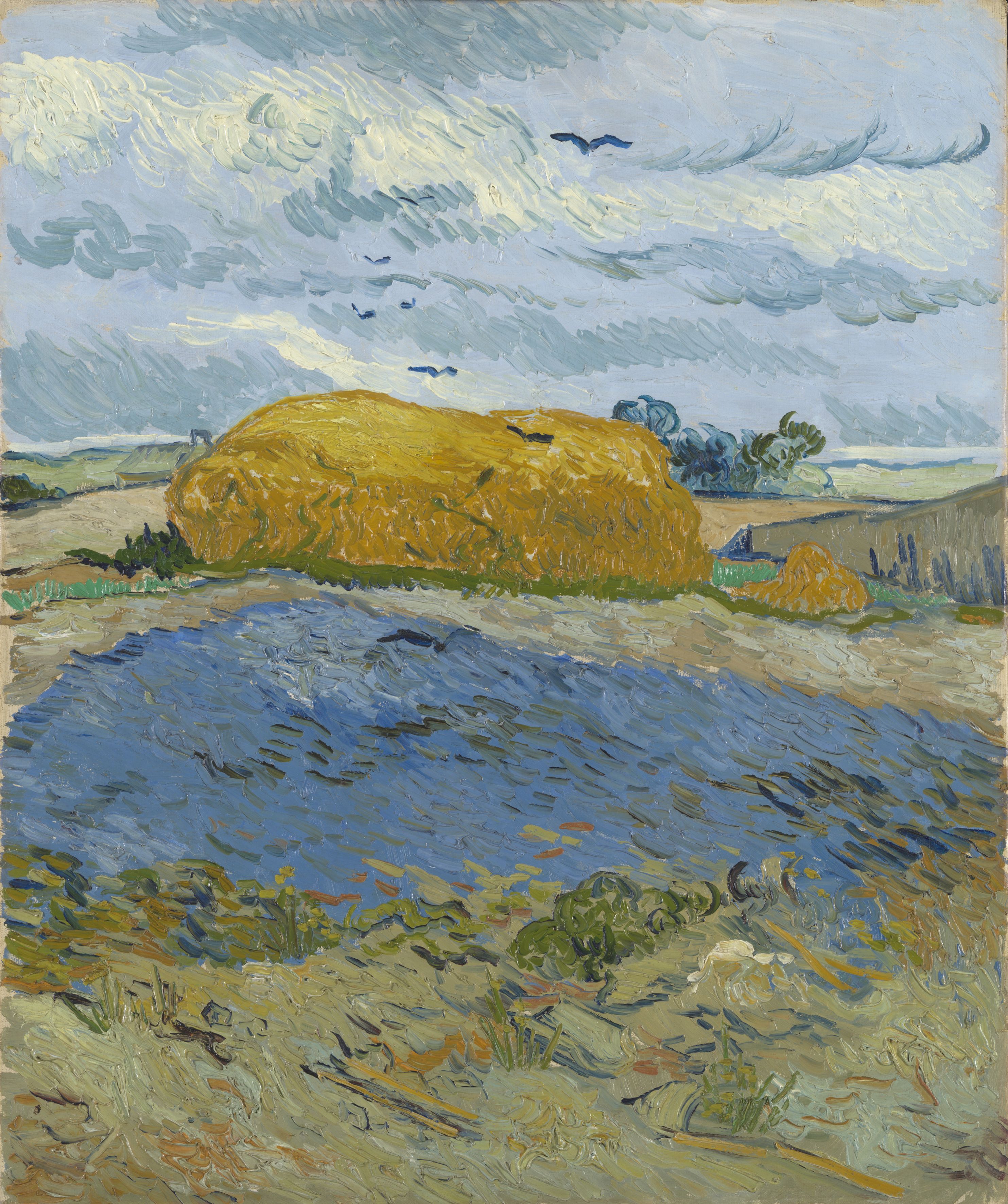
Vincent Van Gogh, Sheaf under a cloudy sky, Auvers-sur-Oise, July 1890 Oil on canvas, 53.7 x 63.3 cm © Kröller-Müller Museum, Otterlo, The Netherland
But it will be the immersion in the light and heat of the south, starting from 1887, to generate even greater openings towards chromatic excesses. Vincent resumes dreaming of symphonies of colors that can be associated with musical tones. Space is generated by color. Returns the image of the Sower. But this time the work, created in Arles in June 1888, is invaded by ancient gold and by unprecedented color combinations with which the artist wants to express joyful sensations. Van Gogh descends into the abyss, but is able to rise suddenly and vehemently.
Vincent’s journey to Palazzo Bonaparte continues and, with his, also that of the visitor. Now the painter feels that such an expressive sphere can only be reached through a metaphysical use of color.
His first attack of madness, in the asylum of Saint-Paul-de-Mausole, strikes him while painting in the fields on a windy day. And so Garden of the hospital in Saint-Rémy (1889) takes on the appearance of an intricate tumult, while the rocky mountains of the Alpilles become swirling tangles where the violent brushstrokes become an expression of the painter’s mood. In the tumultuous universe of Ravine with convulsive shapes that seem to swallow all hope, Van Gogh projects his torments that become inconsolable in the last cry for help entrusted to the Desperate old man (1890) which closes the exhibition.
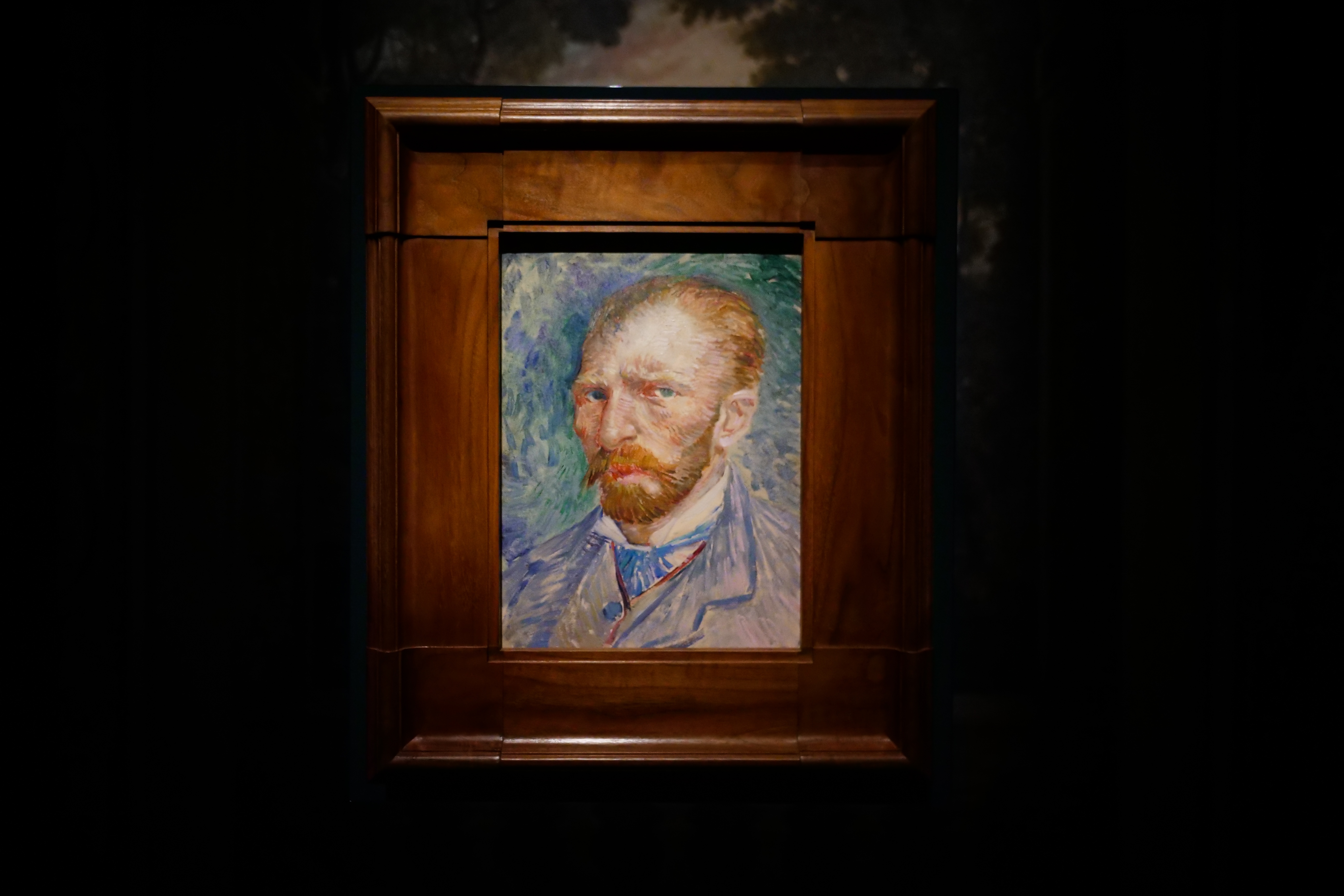
Installation of the Van Gogh exhibition. Masterpieces from the Kröller-Müller Museum
Alongside the works of Van Gogh, the itinerary embraces, in the first section dedicated to Helene Kröller-Müller, who entrusts art with the task of leading society towards the future, some masterpieces from the Dutch collection such as Portrait of a young woman (The Madrilenian) by Picasso, In the café by August Renoir e Atiti by Paul Gauguin.
That “big bristly dog” that enters “the room with wet paws” barking loudly, as Vincent wrote about himself in 1885 in a letter to his brother Theo, will no longer bother. He made his glorious entry into the ages by conquering that same humanity that he had placed at the center of his immense masterpieces, to drag us over a century later, into the magical dream of a starry night.
![]() Read also:
Read also:
• In the world of Van Gogh. The masterpieces of the Kröller-Müller Museum arriving in Rome


Nel 1963, il fotografo e regista di New York Melvin Sokolsky (1933–2022) ha prodotto la serie di fotografie “Bubble” che ritraggono modelli che “galleggiano” in gigantesche bolle di plastica trasparente sospese a mezz’aria sopra la Senna a Parigi.
h/t: vintag.es

“La bolla della serie è realizzata in Plastivew ed è composta da due emisferi con una fessura da 1/8 di pollice per consentire il respiro. Quindi la bolla è stata appesa a un cavo molto sottile ma resistente. (Potrebbe anche reggere una Cadillac.) Questo è stato probabilmente uno degli scatti più facili che abbia mai fatto in vita mia perché non ci sono state interruzioni di capelli o trucco. Nessuno poteva toccarla nella bolla, quindi eravamo solo io e lei a creare le immagini”. – Melvin Sokolsky

Melvin Sokolsky era meglio conosciuto per le sue fotografie editoriali di moda per pubblicazioni come Harper’s Bazaar, Vogue e The New York Times. Il lavoro di Sokolsky non si limita a quel campo. Tre quarti delle sue fotografie stampate sono state per la pubblicità, che di solito non ha un sottotitolo. Verso la fine degli anni ’60 lavorò sia come direttore commerciale che come cameraman.



























Natalya Lobanova (precedentemente descritta qui e qui), fumettista e pittore con sede a Londra, crea rappresentazioni oneste della maggior parte della nostra vita quotidiana. I suoi cartoni animati intelligenti sono spesso presentati in modo semplice, simile a schizzi, ma spesso contengono commenti perspicaci sulla cultura e la società moderne, nonché su come percepiamo queste cose.
Di più: Natalia Lobanova, Instagram h/t: noirpanda

Natalia ha rivelato a Panda annoiato che aveva più di una professione nel campo dell’arte. “Sono anche pittore, illustratore e animatore. Per me, i fumetti tendono ad essere divertenti progetti collaterali che realizzo occasionalmente. Tuttavia, sono le cose che piacciono di più alle persone, perché sono le più riconoscibili! Non c’è da meravigliarsi se le idee di Natalya sono brillanti, sa come lavorare su più di un mezzo.

L’artista ha anche affermato che “nessuno dei miei fumetti divertenti riguarda in particolare la mia vita”, il che è sorprendente dato il numero di persone che si relazionano al suo lavoro. “Tendo a concentrarmi maggiormente sui sentimenti universali che credo tutti sperimentino, di solito di angoscia esistenziale! Evito deliberatamente di disegnare me stesso nei fumetti, motivo per cui a volte ricorro a una persona amorfa simile a un blob, poiché la vedo come una sorta di ‘anti-personaggio'”.





























































Leonora Carrington, Artes 1101944. Collection of Pearl & Stan Goodman, lovede gave til NSU Art Museum, Fort Lauderdale, USA © Estate of Leonora Carrington / ViSDA
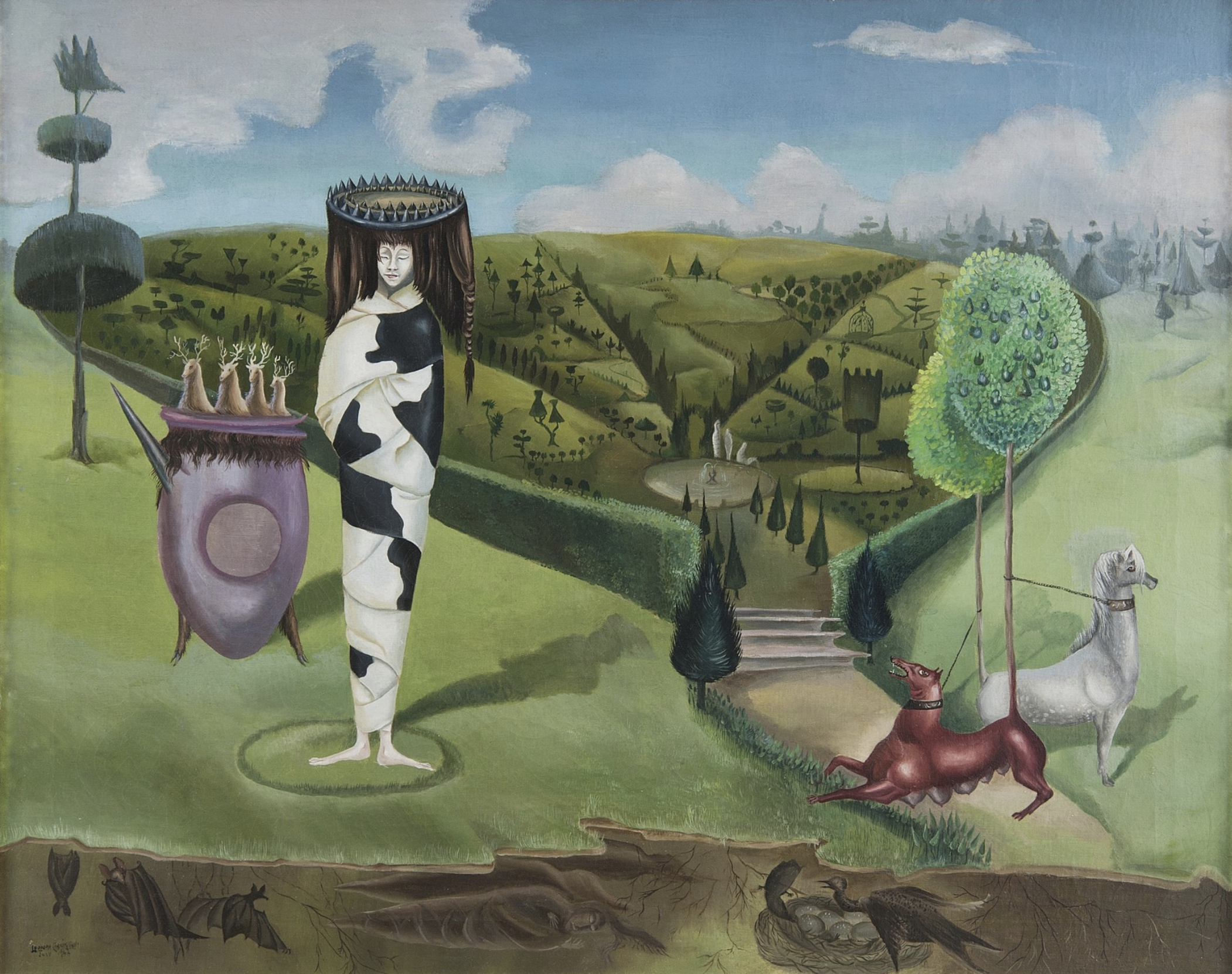
Leonora Carrington, Green Tea (The Oval Lady), 1942. The Museum of Modern Art, New York. Gift from Drue Heinz Trust (exchange) 2019 © Estate of Leonora Carrington / VISDA. Unknown photographer
Over one hundred 100 works – including Carrington’s paintings, drawings, tapestries, sculptures and books, and works by artists such as Remedios Varo or Max Ernst – tell of an experimental artistic universe, rich in mythology, esotericism and feminist perspectives.
“Leonora Carrington’s artistic vision of freedom and equality – explains the curator of the exhibition Sarah Fredholm – is more relevant than ever in times of global warming, natural disasters and war. In response to the crises of our time, spirituality, the occult and the forces of nature are being cultivated more and more, for example through astrology, tarot and witchcraft. Carrington possessed incredible power and mystery. She remained unique, created her own version of Surrealism, and was not limited by either men or women. surrealist movement. As an artist, challenge our way of seeing the world “.
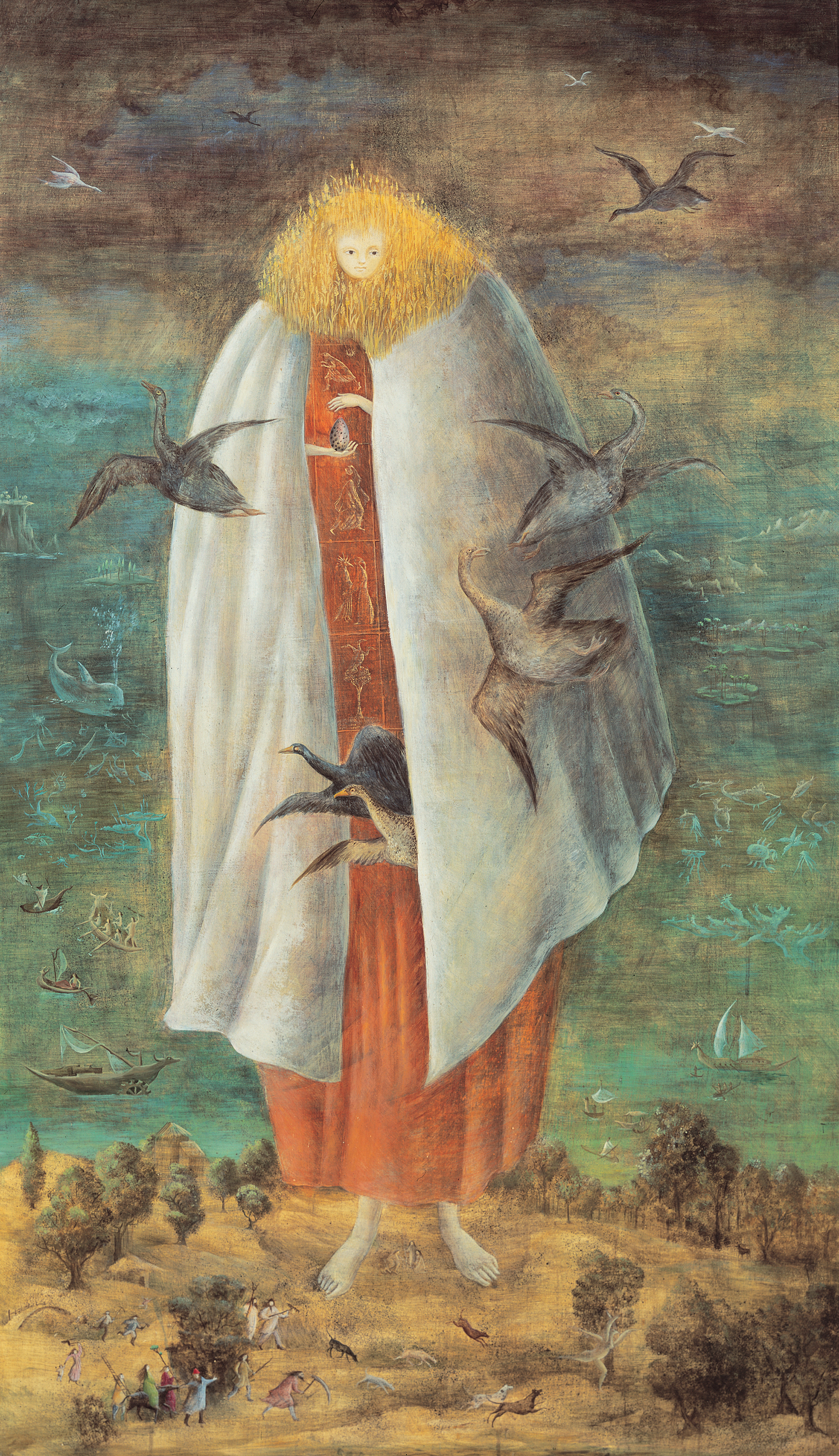
Leonora Carrington, The Giantess (The Guardian of the Egg), 1947. Private collection © Estate of Leonora Carrington / VISDA. Unknown photographer
Intransigent and visionary, Carrington has in fact placed his freedom above all else. Moving away from a rigid bourgeois education, she reached Paris at the age of twenty to pursue a career as an artist. Within the inner circle of the surrealist movement, she met the painter Max Ernst and had a relationship with him. She then she, during the Second World War, she in a war-torn Europe, she flees her to Mexico, where she settled dealing with Mexican culture and religion.
Now, during his stop in Denmark, on the occasion of his first major exhibition in Scandinavia, the public will be able to follow Carrington’s life and career with key works arriving from England, the United States and Mexico, flanked by letters , photographs and major loans from private collections.
The artist’s interest in magic, alchemy, witchcraft overwhelms visitors making their way through fantastic characters in a state of perpetual transformation, while the boundaries between humans, animals and nature become increasingly blurred. What attracts is an art steeped in memories, from involuntary engagement in a psychiatric hospital in Santander, Spain, to his exile during World War II. The themes of confinement and transformation are well expressed in the work Green Tea (The Oval Lady), created by Leonora one year after her hospitalization. Everything revolves around the two horses tied to each other’s tails, while, under the earth’s surface, some beings recall the female figure wrapped in the foreground, the painter herself.

Leonora Carrington, The Artist Traveling Incognito, 1949. Rowland Weinstein, Weinstein Gallery, San Francisco © Estate of Leonora Carrington / VISDA. Photo: © Nicholas Pishvanov
Through a visual language full of poetry, Leonora Carrington faces human psychology, its change and renewal, opening the way to magical realms where everything is out of the ordinary. Inhabited by strong women, mythological goddesses, historical female figures and wise women, Carrington’s art drags us into the history of the occult, of alchemy, making us aware of how women have had great authority in many indigenous cultures.
If female characters claim power, oracles and alchemists become creatures with healing and magical powers, with access to unknown territories, capable of summoning new worlds.
With her art, Carrington directs a feminist critique of oppressive power hierarchies, as seen, for example, in the self-portrait The Artist traveling Incognito. The work contrasts with the trend of the surrealist movement dominated by men who tend to worship the female figure as a young, beautiful muse with a boundless imagination, capable of inspiring the male artist.
“I didn’t have time to be anyone’s muse… I was too busy rebelling against my family and learning how to be an artist,” Carrington said in an interview, not very enthusiastic about the “muse” label.
After ARKEN, where it can be admired until January 15, the exhibition will reach the Fundación MAPFRE in Madrid.
![]() Read also:
Read also:
• In the dreamlike universe of Leonora Carrington, the surrealist of the 2022 Art Biennale
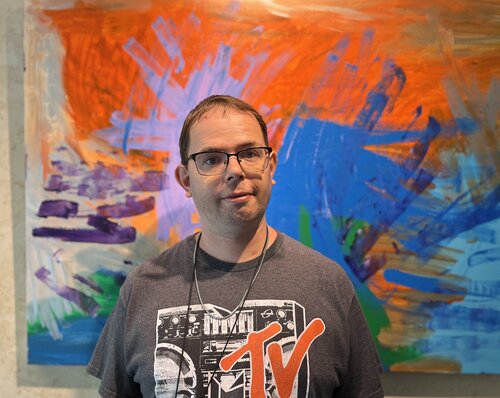
di Carolyn Edlund

L’artista Wiley Johnson con la sua pittura.
JJ: Wiley ha un disturbo dello spettro autistico. La scuola era sempre difficile per lui. È diventato depresso dopo aver finito il liceo quando non è stato in grado di trovare un lavoro. Successivamente è stato ricoverato in un ospedale psichiatrico. Sono rimasto inorridito all’idea di visitarlo e trovarlo troppo medicato e nell’apprendere che era stato sottoposto a restrizioni fisiche. L’ho fatto trasferire in un altro ospedale, ma è andato avanti con una serie di ricoveri e case famiglia che lo hanno fatto arrabbiare e ritirarsi. Non aveva uno scopo nella vita. Alla fine sono diventato disabile e ho dovuto lasciare il mio lavoro di medico, ma questo mi ha dato la possibilità di provare a fare un posto per Wiley.
Wiley ha la fortuna di avere personale 3-4 ore/giorno, 5-6 giorni/settimana retribuito nell’ambito di un programma Medicaid chiamato Innovations Waiver per le persone con disabilità intellettive e dello sviluppo. Sono stato in grado di assumere personale per lavorare con lui piuttosto che dipendere da un’agenzia per il personale. Wiley mi ha chiesto: “Perché non puoi assumere un artista per lavorare con me?” All’inizio mi chiedevo come sarebbe stato possibile, ma alla fine ho capito che valeva la pena provare. Abbiamo assunto il nostro primo artista nel 2020 e abbiamo iniziato Il sito web di Wiley e account Instagram e Facebook. Non avremmo mai potuto progredire così rapidamente nella carriera artistica di Wiley senza il supporto di artisti con competenze sui social media e sui siti Web ad assisterci.
JJ: Wiley ha iniziato a dipingere intorno al 2009. Gli ho comprato una casa a schiera in quel momento. Anni prima aveva dipinto un po’ durante le lezioni di arteterapia in ospedale, e questo gli dava qualcosa da fare quando era solo, ma lo consideravo solo un hobby. Il primo invito di Wiley a esporre è venuto dal Spazzola con la vita programma al North Carolina Memorial Hospital di Chapel Hill, NC. Ho visto come ha preso vita quando le persone hanno commentato che gli piaceva la sua arte. Un amico ha suggerito che Wiley potrebbe sviluppare un business con la sua arte, ma sembrava inverosimile. Tuttavia, stava producendo, quindi ho cercato eventi in cui avrebbe potuto vendere la sua arte.
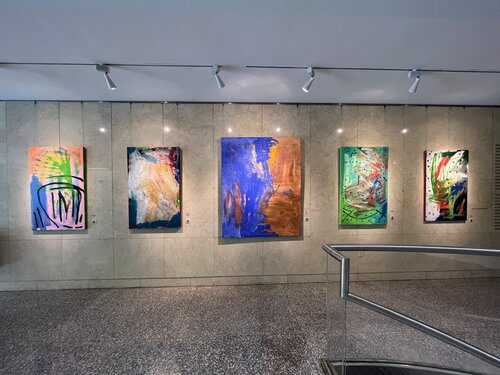
L’arte di Wiley Johnson è stata esposta in diverse mostre.
JJ: Una sfida per me è stata trovare opportunità per Wiley di mostrare la sua arte. Poi ho scoperto un’organizzazione per persone con disabilità che avrebbe organizzato 1-2 eventi di vendita d’arte all’anno. Alcuni membri della famiglia acquistarono la sua arte. Ho visto com’era felice di vendere un piccolo dipinto per una modica cifra.
Mi sono collegato con l’organizzazione locale Accesso alle arti, e in seguito si è offerto volontario per partecipare a un video per raccogliere fondi per loro. Alcuni anni dopo, il loro staff mi ha consigliato di partecipare a un seminario tramite Triangle Artworks. Hanno elencato le chiamate artistiche mensili! Ci siamo uniti a Visual Art Exchange a Raleigh, che ha dato a Wiley l’opportunità di esporre. Entro il 2019 siamo andati a dare un’occhiata ad altri luoghi che hanno curato. Wiley avrebbe dovuto dipingere tele più grandi per essere considerato.
Ci siamo uniti Spazio artistico nel 2019 e ha ricevuto carte e stampe nel loro negozio di articoli da regalo. Ciò ha portato a opportunità con altre attività commerciali locali e un ristorante che ha esposto le sue opere d’arte. Arts Access ha offerto una mostra personale al Raleigh Woman’s Club nel gennaio 2020. La pandemia ha rallentato le cose, ma fortunatamente i dipinti di Wiley sono stati accettati in quattro mostre collettive con giuria nel 2020 fuori Raleigh e in una in città.
Wiley ha avuto una grande occasione nel 2020 da uno dei nostri primi post su Facebook, quando un cliente ha acquistato due dipinti per $ 1.000. Ho immaginato che se una persona avesse speso così tanti soldi, ci sarebbero state altre persone nel mondo che avrebbero anche apprezzato e apprezzato la sua arte. ArtLifting (un sito che sostiene artisti con disabilità) ha accettato Wiley come primo artista della Carolina del Nord nel 2020. Poi la banca Chase a Durham, NC, ha acquistato una licenza nel 2021 tramite ArtLifting per installare due grandi riproduzioni di Wiley’s Art. Abbiamo formato una LLC su consiglio del mio avvocato quando abbiamo appreso dell’imminente vendita.
Non avrei mai immaginato che l’arte di Wiley sarebbe stata esposta in così tante gallerie e mostre quando ha iniziato a dipingere. ~ Gioia Johnson
JJ: Molte cose sono successe negli ultimi anni. Arts Access è stato determinante per ottenere la copertura iniziale di Wiley in a Walter articolo di una rivista sulla disabilità e le arti. Hanno intervistato il regista, che li ha indirizzati a me ea Wiley. Quindi Arts Access ha acquistato un dipinto e ha presentato Wiley come artista dell’anno. Spectrum News ha condotto un’intervista che è stata trasmessa più volte dalla televisione locale.
Successivamente, più riviste locali hanno coperto l’apertura del Cambusa contemporanea di Charlotte Russell, che presenta artisti sottorappresentati, tra cui Wiley. Il Regency Center ha pubblicato uno speciale nella sua newsletter commerciale online dopo aver acquistato una licenza per installare una replica di uno dei dipinti di Wiley a Raleigh.
Ho assunto un copy editor per supportare la microimpresa artistica di Wiley e lei si prende cura dei suoi social media. È rimasta così colpita dal servizio della Charlotte Russell Gallery e da una mostra al Sertoma che ha convinto il suo capo del North State Journal a lasciargliela scrivere un articolo sull’arte di Wiley.
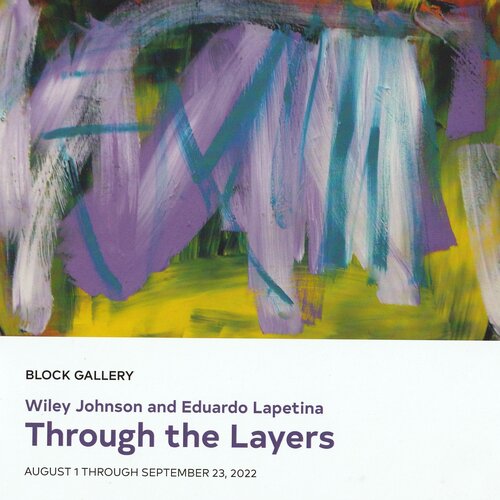
L’annuncio di una mostra imminente presenta il lavoro di Johnson.
JJ: Wiley ora ha una vocazione e uno scopo nella vita. È stato reso possibile dal sostegno della famiglia e della comunità al suo desiderio di dipingere ed esporre, oltre a fornire un reddito molto modesto.
I miei consigli per gli altri sono:
I passaggi precedenti possono aiutarti a sviluppare una cronologia della mostra. All’inizio non mi bloccherei con le vendite se la pittura ti rendesse felice.

Preparation of the exhibition Twentieth century passion from Paul Klee to Damien Hirst. Works from private collections | Courtesy Museo Novecento
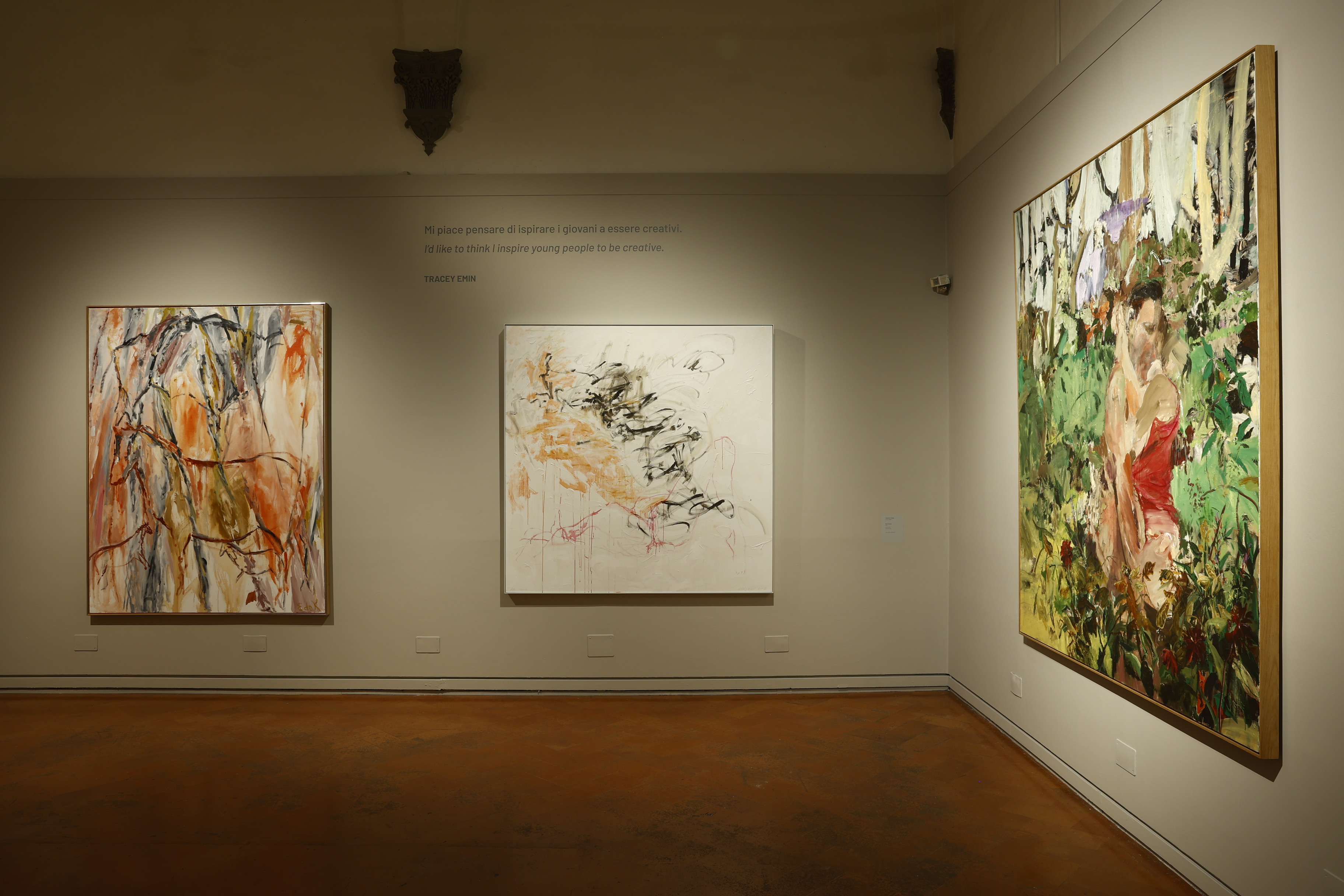
Twentieth century passion from Paul Klee to Damien Hirst. Works from private collections, Exhibition design | Courtesy Museo Novecento
In the city cradle of the Renaissance, which over the centuries has seen artistic events and those of private collecting intertwine, sowing a sensitive predisposition to the avant-garde and its most advanced experiments throughout the territory, a red thread links the ancient families of the Sassetti and Tornabuoni , the Medici and the Doni, the Gondi and the Rucellai to the private collectors of today.
In this anthology of eras and styles, visitors to Palazzo Medici Riccardi will be able to admire rare masterpieces by Paul Klee and de Chirico in dialogue with the Circus by Ottone Rosai, with the Abandoned objects in the forest by Alberto Savinio, and again with the works of Martini and Melotti, Burri and Fontana, with works by Warhol and Lichtenstein, Alighiero Boetti and Damien Hirst, with the Girolamo Savonarola by Ai Weiwei or the Couple by Cecily Brown.
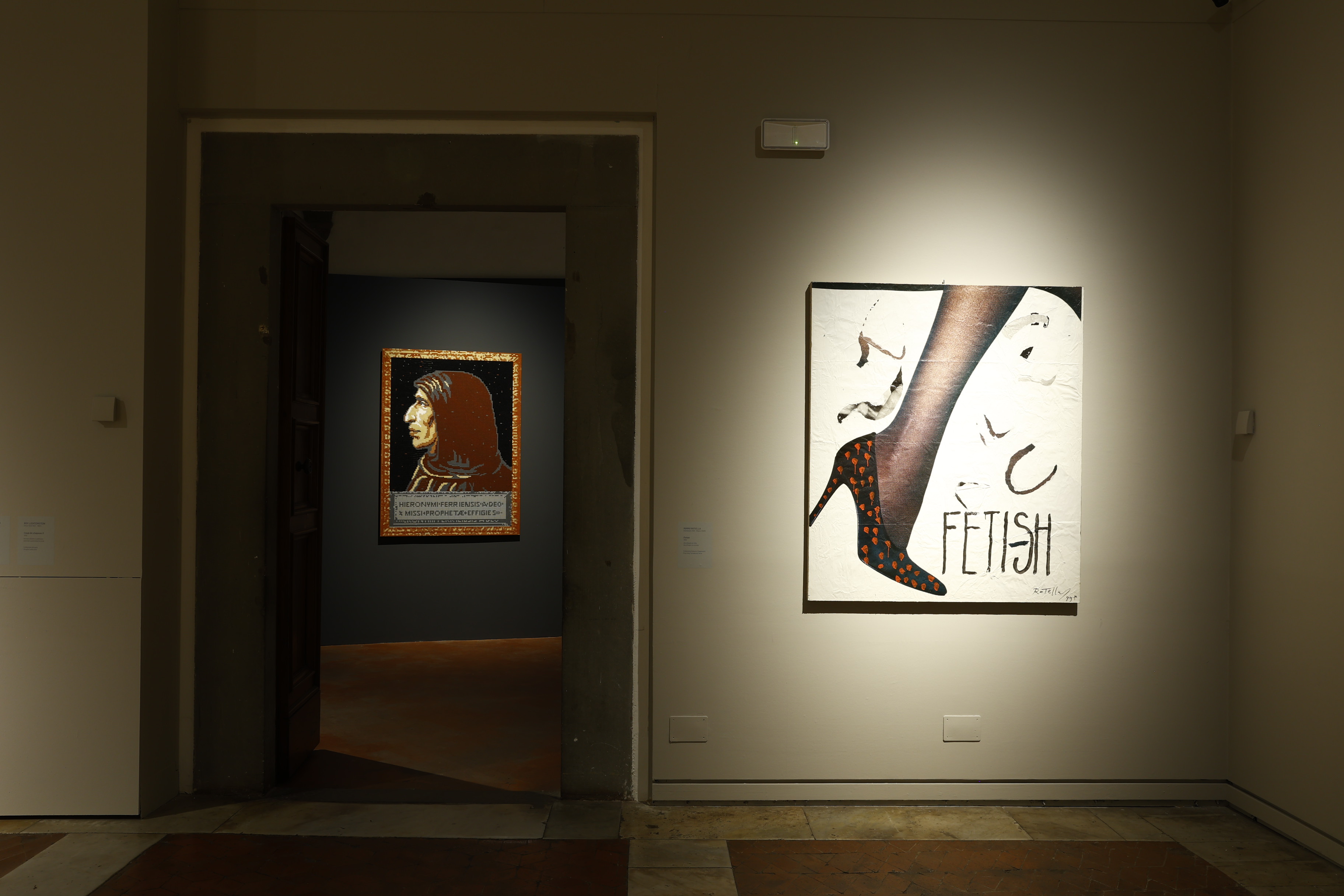
Passion of the Twentieth Century from Paul Klee to Damien Hirst, works from private collections, Staging | Courtesy Museo Novecento
The succession of masterpieces will also see the stories of great art lovers alternate which will allow the modern public to learn more about the collector’s life, taste and ideals in a game of suggestions and meanings. On the other hand, it is thanks to collecting and patronage, which took root in the “rooms” and in the studios of Palazzo Medici, that the autonomy of works of art, curated, contemplated, appreciated for themselves, has been affirmed.
The first modern museums originated from the private collections, studios and salons of the great lords.
Developed during the Renaissance with the Medici family, central to the Italian cultural promotion, patronage was consecrated over the centuries to come with the presence of figures of the caliber of Stefano Bardini, one of the most eclectic and refined antiquarians and merchants of the his time, and the eclectic Frederick Stibbert. And thanks to collecting it is now possible to admire these masterpieces, in an extraordinary journey of rediscovery and deepening of the art of the twentieth century.
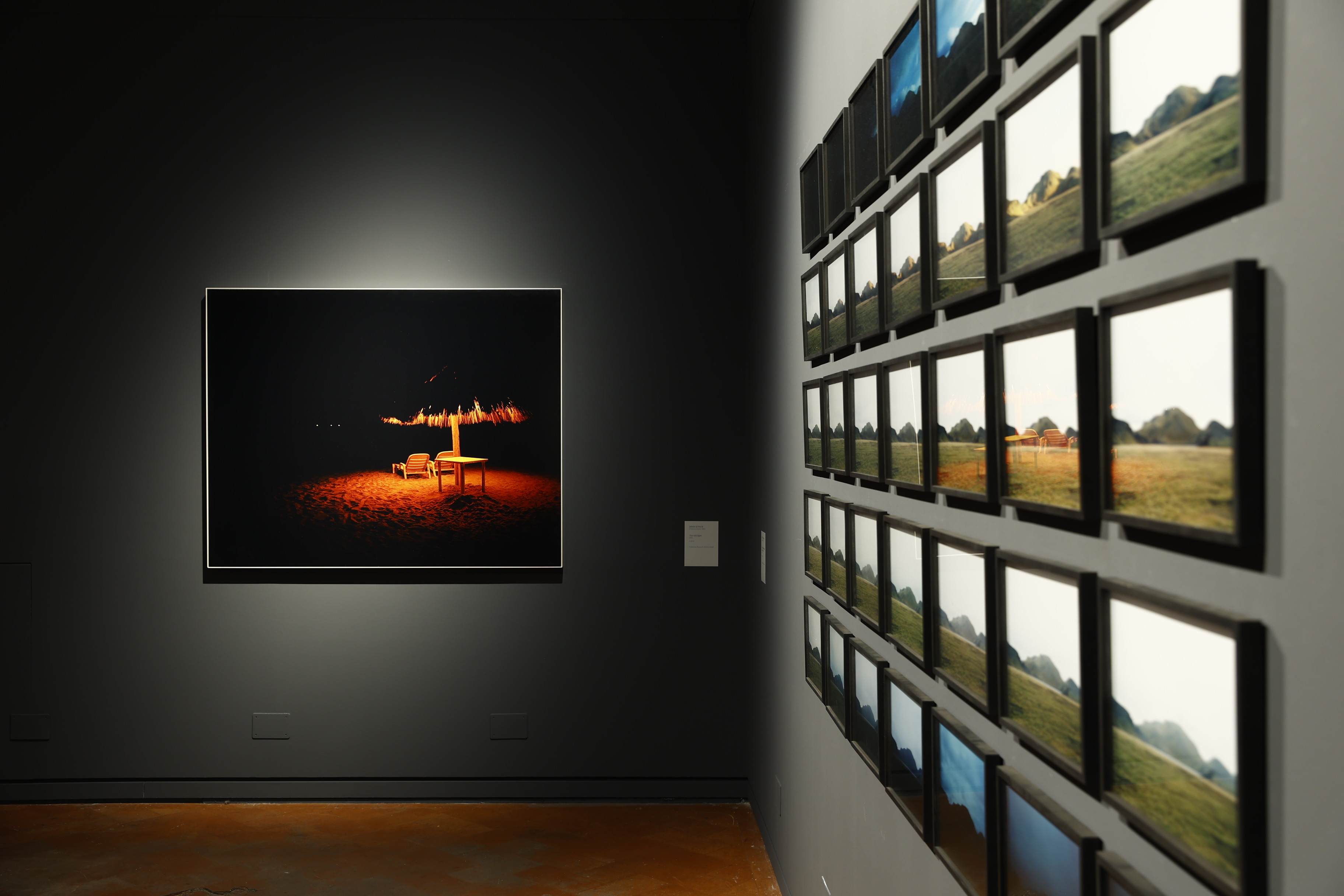
Passion of the Twentieth Century from Paul Klee to Damien Hirst, works from private collections, Staging | Courtesy Museo Novecento
“The Passione Novecento exhibition – explains Sergio Risaliti, director of the Museo Novecento in Florence and curator of the exhibition – will open in conjunction with the Florence Art Week and the International Antiques Biennial which, after the break dictated by the epidemic, will bring the great protagonists back to Florence of the antiques market, together with collectors from all over the world and representative figures of the art system and museums. In the same week, the Renaissance + award will also be presented again in its third edition, an award assigned to six eminent personalities from the world of collecting and patronage ”.
The exhibition can be visited every day, except Wednesdays, from 9 to 19.
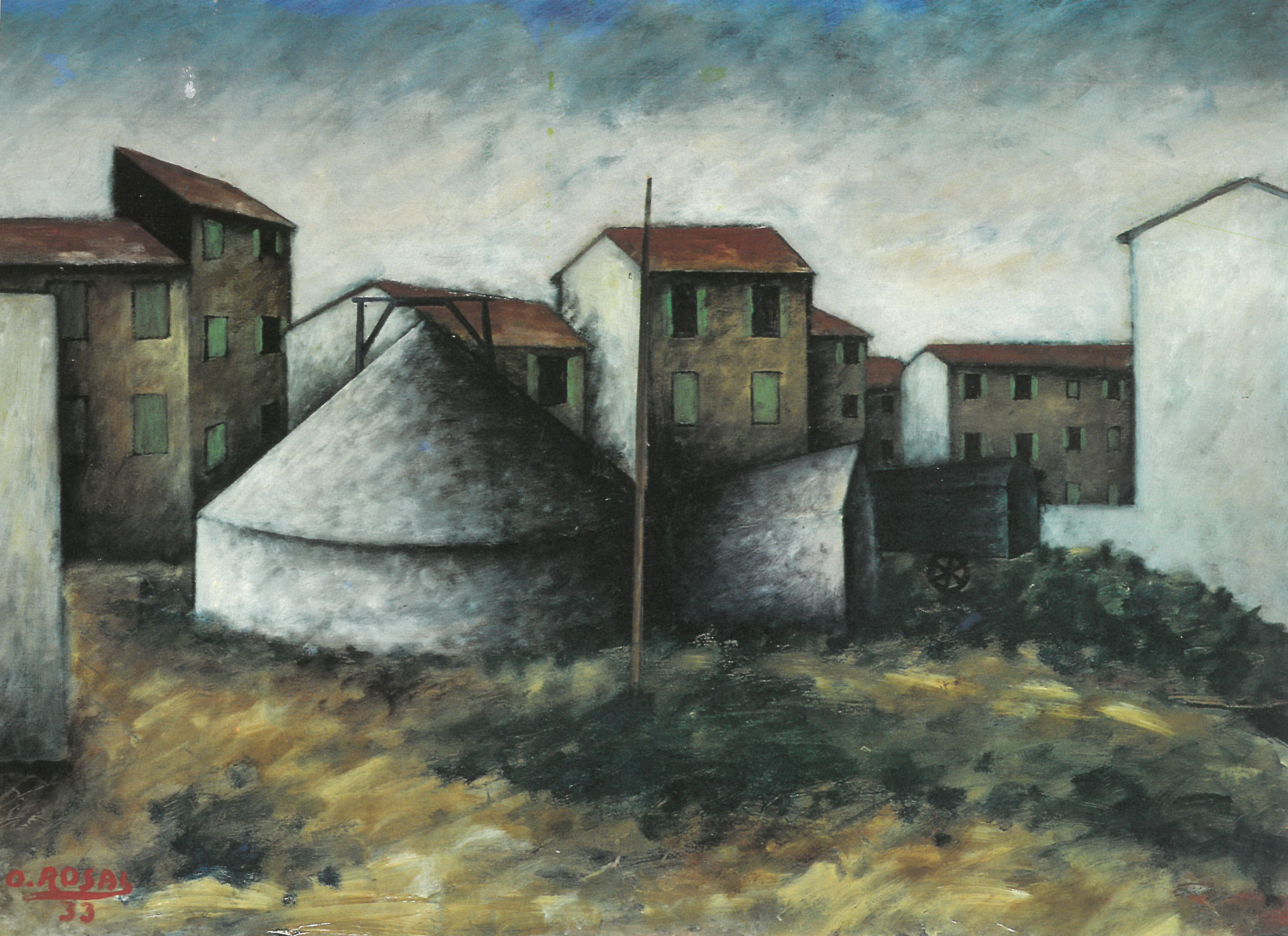
Ottone Rosai, Circus, 1933, Oil on cardboard
Scrivici su WhatsApp